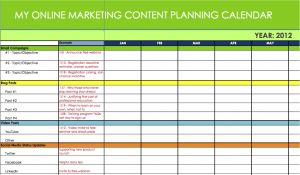Marketing Hacks
Why You Need a Content Marketing Schedule (and How to Create One)
May 22, 2012
There are lots of moving parts to a marketing campaign. You’ve got your blog posts, newsletter, white papers, webinars, podcasts, guest posts, press releases and activity on the social sites. It can be daunting trying to keep everything straight and stay on an organized schedule.
A content marketing schedule is a great way to organize your efforts. Here are some reasons why you need one and how to create it.

Benefit #1 – Better Organization
It’s easy to start an initiative and then quickly forget about it. Once you have developed your strategies, put them down on paper. Create a list of actions that you plan to take and put a date on them. This has been a great way for me to stay focused on my objectives. I tend to suffer from business ADD so if I don’t develop an organized plan then some things tend to slip through the cracks.
Benefit #2 – Keeps your Business Focused on the Future
We use a 60 day content marketing schedule so we know what we plan to do way in advance. This means we list out all of our marketing programs and then assign a specific date they will be completed. It’s not set in stone because we may pivot and create content for a topic that we didn’t anticipate at the beginning of the cycle but it’s a good framework to use.
This helps create continuity with your marketing efforts. You can tweak things here and there but creating a schedule and sticking to it means your audience will know what to expect.
Benefit #3 – You’ll Be Much More Prepared
There are two parts to our schedule. The production calendar is for when our initiatives actually get pushed out to be published. There is another calendar that details when the work needs to be done on these initiatives. Working in unison, you can see from the calendars what needs to be done and when.
Instead of doing a little work here and there, you have an organized schedule that will make it easier to manage your time and stay on task.
So, How Can I Create One?
Creating a list of marketing initiatives is easy, the hard part is planning it all out and making them work together.
Start by listing out all of your marketing assets. Newsletter, blog posts, webinars, white papers, etc… Then, create a spreadsheet with those items listed on the ‘Y’ axis and your timeline on the ‘X’ axis. Here is an example:
Next, drill down in to each item and write out what you plan to do with it over your timeline (we go more granular and list 60 days at a time instead of months). We just started a weekly webinar series so we know that we need to come up with 9 topics for these discussions. Once we have those topics, it’s easy to drop them in to the content schedule so they are officially on the books.
We also list out the day-to-day actions we’ll take to promote the content. For the webinar, we send out an email invitation and complement that with posts on Twitter and relevant LinkedIn group pages. This makes you think strategically about how to best get the word out. It’s also helpful to see exactly where you’re promoting the content so you don’t over saturate a channel.
Now that you have a schedule, you just have to stick to it!
Related articles
- Unleash Infographics In Your Content Marketing & Curated Newsletters (flashissue.com)
- 12 Essential Tools for the Content Marketer (flashissue.com)
- The Marketer’s Code for Building Great Content (flashissue.com)

Continue reading


